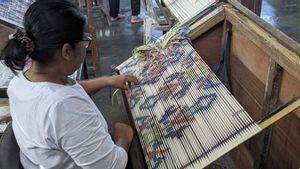JAKARTA - The historic revitalization process of the Potala Palace is currently underway with modern technology. This effort uses a very detailed three-dimensional (3D) model, the complexity of the mural can be displayed in just one click.
More than 1,000 sensors spread across various parts of the palace continue to monitor and record data, providing analysis and interpretation of real-time palace conditions.
The Potala Palace stands majestic at the top of Mount Marpori, or "red hills" in Tibetan, located in the central city of Lhasa, the capital of the Xizang Autonomous Region, southwest China. The palace is one of the most valuable cultural heritages in the region, storing more than 100,000 historical artifacts.
Initially, the Potala Palace was founded in the 7th century by the King of Tibet Songtsen Gampo and later expanded by the fifth Dalai Lama in the 17th century. In 1994, the palace was officially recognized as the UNESCO World Heritage Site, and in 2024 it will be a 30-year anniversary since the recognition.
Over time, this historic site faced serious challenges due to age factors and environmental changes. To overcome this, researchers took advantage of advanced technology to preserve this priceless cultural heritage for future generations.
The unique structure of the Potala Palace, with diverse internal furniture and trapezoid walls, makes this architectural survey quite complicated, said Thubten Tce often, an official at the Potala Palace monitoring center.
"To overcome these obstacles, our team uses technology such as drone photography, 3D laser scanning, and multi-angle image reconstruction to create the palace's digital models as a whole," he explained, as quoted by Antara.
The digital model includes detailed information about various palace elements, including Buddha statues, murals, Thangka paintings, wood components, to the wall structure. With this digital model, we can understand the palace's cultural architecture and artifacts more deeply," he added.
For example, researchers can study cultural artifacts through 360 degree high-definition images without having to touch their physical objects, so that the risk of damage can be minimized.
Murals that adorn the palace have a tremendous degree of complexity. Some murals even require up to 4050 photos that are combined into one complete image.
This digitalization process took nearly four years. During that period, our team used cameras with various pixel resolutions to produce accurate mural images on a 1:1 scale, said Tashi Tsten, an official from the Potala Palace Management Office.
VOIR éGALEMENT:
To date, the team has captured a high-resolution mural covering an area of nearly 2,500 square meters.
The Potala Palace complex structure faces long-term weathering risks and geological changes that could affect its stability. To anticipate this, more than 1,000 sensors have been installed in various parts of the palace. These sensors include crack gauges, slope gauges, soil moisture sensors, and air temperature sensors.
This monitoring system works 24 hours to track changes in cracks, environmental temperatures, wall slopes, beam deformations, and crowd loads. The resulting data is very important in evaluating the stability of the wooden structure, walls, and the foundation of the palace," said Thubten.
Each sensor is equipped with a QR code that functions as a unique identity. By scanning this code, researchers can access both historical and real-time monitoring data.
To reduce the risk of a fire, the cable connection at the palace has been replaced by fiber optics and then wireless transmission technology. This step allows us to record structural changes without disrupting the palace's architectural integrity," he added.
The English, Chinese, Japanese, Arabic, and French versions are automatically generated by the AI. So there may still be inaccuracies in translating, please always see Indonesian as our main language. (system supported by DigitalSiber.id)













